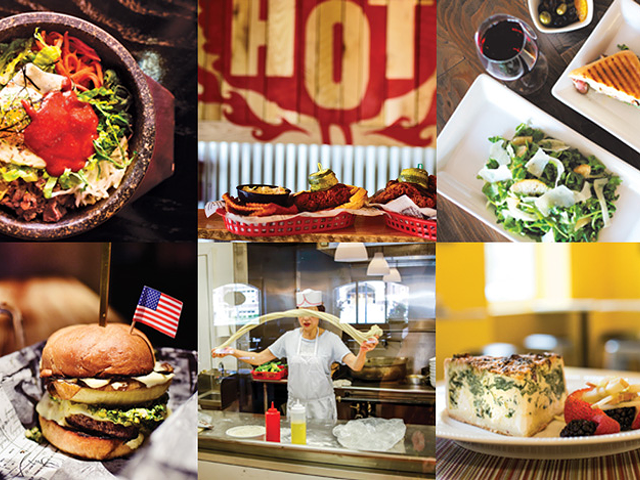Objectively speaking, 2016 was an absolute dumpster fire. If life was a Nintendo 64, I’d have hit the restart button last January. Sadly, there is no restart button in life, but there is in food trends. Let “out with the old, in with the new” be the mantra you whisper under your breath as you sip apple cider vinegar.
Ten years ago, diets like gluten-free or vegan meant eating bread and salad at a restaurant. Now any restaurant worth its weight in nutritional yeast not only has diet-friendly options, but tasty diet-friendly options. Coconut oil showed us how trends often hit the health community and then crossover into the mainstream.
Foods that are good not only on the tongue but for the entire body will continue to gain popularity in 2017. Watch for buzzwords like “detox,” “single-origin,” “vitamin-enhanced” and “traditional.” After 2016, we all need a little detox anyway.
Out with Cheese, in with Nutritional Yeast
Well, sort of. Don’t worry. Cheese isn’t going anywhere. But the rise of nutritional yeast, a yellow deactivated yeast popular for its cheese-like flavor and yellow color, is finally reaching the mainstream.
As veganism and vegetarianism continue to reach a wider audience and trend diets like Paleo and gluten-free (which will also continue to surge in 2017) grow, the diet-friendly nutritional yeast will grow with it. That’s because nutritious food is sexy, and nutritional yeast is, in fact, nutritional, averaging 60 calories per vitamin-enhanced tablespoon.
Nutritional yeast is commonly sold in a flaked form and can be sprinkled on mashed potatoes, popcorn, noodles — anything you would put cheese on. It can also be incorporated into more complicated dishes, like sauces. Look for more organic and farm-to-table restaurants or stores to begin incorporating the ingredient into the menu.
Out with Kombucha, in with Apple Cider Vinegar
Kombucha is one of those trends that I didn’t realize I was participating in until I tried to swallow down the tart, bitter liquid because my brother said all of his cool friends drank it (and yes, I really am that easily manipulated).
It seemed like only a week later that restaurants around Cincinnati were offering the fermented drink on tap next to craft beers. Kombucha has grown in popularity because it contains detoxifying bacterial acids, with some suggesting its glucaric acids might be cancer-preventative.
However, a bottle of craft Kombucha can sometimes cost as much as a sandwich, and in the last few months I’ve seen more and more people reaching for a bottle of apple cider vinegar (which I only used to have around to kill fruit flies). Raw apple cider vinegar mirrors Kombucha’s detoxifying acids, enzymes and minerals with a more budget-friendly price point.
Out with Spicy, in with Turmeric
Every year, for some reason unknown to me, a spice suddenly becomes insanely popular. The McCormick spice company actually puts out Flavor Forecasts, where it predicts what spices and flavors will catch on in the upcoming year (2016 saw a rise in Asian spices and spicy/tangy).
In 2017, I predict turmeric, a powder derived from the ginger family, will finally see its day. Turmeric is a staple in South African, Thai and Indonesian cooking. Already I’ve seen people I know slather it on their faces and body or throw the powder in smoothies due to the spice’s traditional medicinal properties.
The subtly bitter flavor pairs well with meats and vegetables, all the while providing a pop of color in any dish. This trend will show a shift from Asian flavors to more Middle Eastern flavors, as well as highlight the popularity of bitter as a new mainstream flavor (like the apple cider vinegar).
Out with ‘Asian Fusion,’ in with De-Fusion
Fusion dining was a celebration of an increasingly global culture swirling together on your dinner plate. But once creations like wasabi cheeseburgers hit chain restaurants like Applebee’s, fusion dining’s moment started to pass.
A growing number of restaurants and stores have begun to offer increasingly specific dining. Brezel in OTR specializes in Bavarian pretzels. Pho Lang Thang at Findlay specializes in pho. Coffee shops offer single-origin espresso pours, profiling the unique taste of a single bean type from a single country or city — and therefore inadvertently profiling the place of origin.
This doesn’t mean restaurants will forgo having a wide menu. It means that many restaurants will trim the 1990s excess off their menus and refine the flavor profiles and cultural influences they’re already serving. For example, look to Fortune Noodle House in Clifton. Mirroring traditional Chinese noodle houses, the restaurant offers to-die-for hand-pulled noodles as well as staple Chinese dishes like salt and pepper tofu or satuéed pig kidney. No Asian fusion necessary.
Out with Coconut Oil, in with Avocado Oil
For a second there, I thought I was going to drown in coconut oil. It was in my coffee. It was in my makeup remover. It was being used to fry my dang potato chips.
I still have a bottle of coconut oil in my pantry, but I might switch it out soon for avocado oil. While avocados scored big on toast in 2016, we’ll see their oil — made by pressing and removing the oil from the avocado “guac” pulp — rise in 2017.
Avocado oil passes the gluten-free and vegan test, allowing anyone to enjoy it. Avocado oil also has a smoke point of 500 degrees Fahrenheit, allowing it to be used for frying (coconut oil has a smoke point of 350 degrees). This is important, as any mainstream oil will really conquer the throne due to its use in potato chips. And I just bought a bag of avocado oil potato chips from Whole Foods for lunch, so let the trend begin. ©





